Tag: California history
A Californiana Returns to the Bay Area: Ana María de la Guerra de Robinson
Women’s history month is the perfect time to announce an exciting addition to Bancroft Library’s collection of daguerreotype portraits. At the end of 2023 the library was able to acquire a beautiful 1850s portrait of a Californiana: doña Ana María de la Guerra de Robinson, also known as Anita.
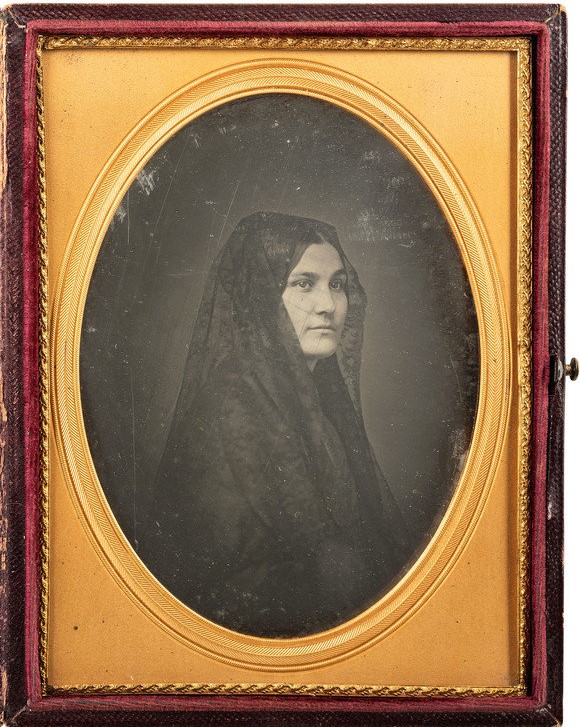
In this large (half plate format) daguerreotype of about 1850-1855, Anita wears a lace mantilla, in the Spanish fashion. A beautiful large daguerreotype like this was an extravagance at the time, and the portrait is all the more evocative because Anita, tragically, died within a few years of its creation.
Fortunately, quite a bit is known about her life. Anita was born into the prominent de la Guerra family of Santa Barbara in 1821 -– the same year the Spanish colonial period ended and control by an independent Mexico began. She was married at age 14, to an American trader and businessman named Alfred Robinson, 14 years her senior. This wedding is described in Richard Henry Dana’s Two Years Before the Mast, so we have an unusually detailed account of what was a grand occasion.
She and her husband snuck away from her family in 1838, leaving their baby daughter behind with her grandparents. Anita, age 15, wrote ”We have left the house like criminals and left here those who have possession of our hearts.” Various writers have interpreted these circumstances differently but, whatever the reason for this strange departure, Anita spent the next 15 years in Boston and the East Coast, seemingly eager to return home, but continually disappointed in the hope. It is hard to imagine that her life was entirely happy, in spite of the steady growth of her family and the prosperity and social prominence the Robinsons and de la Guerras enjoyed.
Having borne seven children, and having witnessed from afar (and apparently mourned) the transition of her homeland from Mexican territory to American statehood, Anita finally returned to California in the summer of 1852. It is likely she had her daguerreotype portrait taken at this time, in San Francisco, although it could have been taken back east. Sadly, she lived just three more years in California, dying in Los Angeles in November 1855, a few weeks after giving birth to a son. She is buried at Mission Santa Barbara.
A study of Anita’s life was published by Michele Brewster in the Southern California Quarterly in 2020 (v.102 no. 2, pg. 101-42) . Read more of her story!
With such a fascinating and relatively well-documented life, we’re thrilled to have Anita’s beautiful portrait here at Bancroft. It joins other de la Guerra family portraits, as well as numerous papers related to the family, including “Documentos para la historia de California” (BANC MSS C-B 59-65) by her father, José de la Guerra y Noriega.
Two of Anita’s sisters had “testimonias” recorded by H.H. Bancroft and his staff; one from Doña Teresa de la Guerra de Hartnell (BANC MSS C-E 67) and another from Angustias de la Guerra de Ord (BANC MSS C-D 134).
Anita’s daguerreotype itself presents an interesting conundrum and history. The photographer is unknown, as is common with daguerreotypes. The portrait has been known over the years because later copies exist in several historical collections, including the California Historical Society, the Massachusetts Historical Society, and Bancroft Library’s own Portrait File.
The daguerreotype acquired last Fall was owned for some decades by a collector. When he acquired it, it was unidentified. Later he encountered a reproduction of it in a historical publication, and thus had the identification of the sitter. Each of the known copies is somewhat different from the others. In her article, Brewster reproduces the copy from the Massachusetts Historical Society. It is a paper print on a carte de visite mount bearing the imprint of San Francisco photographer William Shew, at 115 Kearny Street.
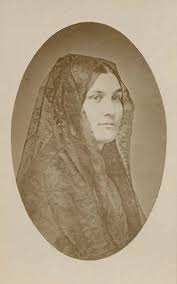
Based on this information, Brewster attributed the portrait to Shew; however, Shew is merely the copy photographer. A daguerreotype, largely out of use by the 1860s, is a unique original, not printed from a negative, so only one exists unless it is copied by camera. The carte de visite format was not in widespread use until the 1860s, and Shew was not at the Kearny address until the 1872-1879 period. So the photographer remains unidentified.
Another puzzle is posed by the early 20th century reproductions in the Bancroft Portrait File and the California Historical Society, which appear identical. These copies present a less closely cropped pose than the original daguerreotype, which is perplexing! Anita’s lap and hands are visible in the copies, but not in the daguerreotype. Although the bottom of the daguerreotype plate is obscured by its brass mat, there is not enough room at the lower edge to include these details.
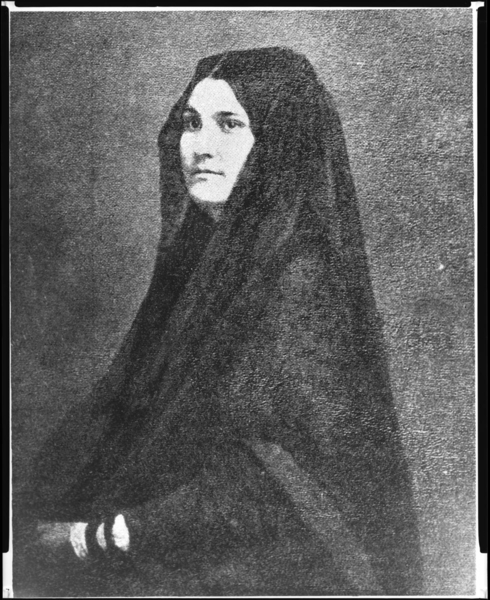
How could a copy contain more image area than the original? Upon reflection, two possibilities come to mind:
1) the daguerreotype was copied in the 19th century and photographically enlarged, then re-touched or painted over to yield a larger portrait that included her lap and hand, added by an artist. This reproduction was later photographed to produce the copies in the Portrait File and CHS.
or,
2) the original daguerreotype included her lap and hand, and it was re-daguerreotyped for family members in the 1850s, perhaps near the time of Anita’s 1855 death. When the copy daguerreotypes were made, they were composed more tightly in on the sitter, omitting the lap and hands. The newly acquired Bancroft daguerreotype could be a copy of a still earlier plate – and this earlier plate could be the source of the later paper copy in the Portrait file.
This will likely remain a mystery until other variants of this portrait surface. Are there other versions of this portrait of Anita de la Guerra de Robinson to be revealed?
Reference
Brewster, Michele M. “A Californiana in Two Worlds: Anita de La Guerra Robinson, 1821–1855.” Southern California Quarterly 102, no. 2 (2020): 101–42. https://www.jstor.org/stable/27085996.
Bancroft Roundtable: California and the Making of ‘Latin America’: A View From the 19th-Century Hemispheric Archive
California and the Making of ‘Latin America’: A View From the 19th-Century Hemispheric Archive
February 16, 2023 | Noon | Register via Zoom
Presented by Alexander Chaparro-Silva, Ph.D. candidate in history, The University of Texas at Austin, and 2022 recipient of The Bancroft Library Summer Study Award
During the 19th century, many intellectuals and diplomats from Latin America came to California, published continental newspapers and books, sponsored intellectual circles and political clubs, and established transnational correspondence networks to engage with the political problems common to the American hemisphere. These transnational crossings contributed to debates over slavery, citizenship, and immigration in Latin America and reinforced an Anglo/Latin distinction within the hemisphere as the boundary between two competing civilizations. Drawing upon 19th-century printed materials, travelogues, diaries, official documents, and diplomatic correspondence — many from The Bancroft Library — Alexander Chaparro-Silva will explore the role of these hemispheric mobilities in the making of the geopolitical category of “Latin America,” and reflect on the possibilities and challenges of assembling a hemispheric archive dispersed across a vast geography.
We look forward to seeing you at these talks.
Hon. Loni Hancock: Member of the California State Senate, December 2008-November 2016
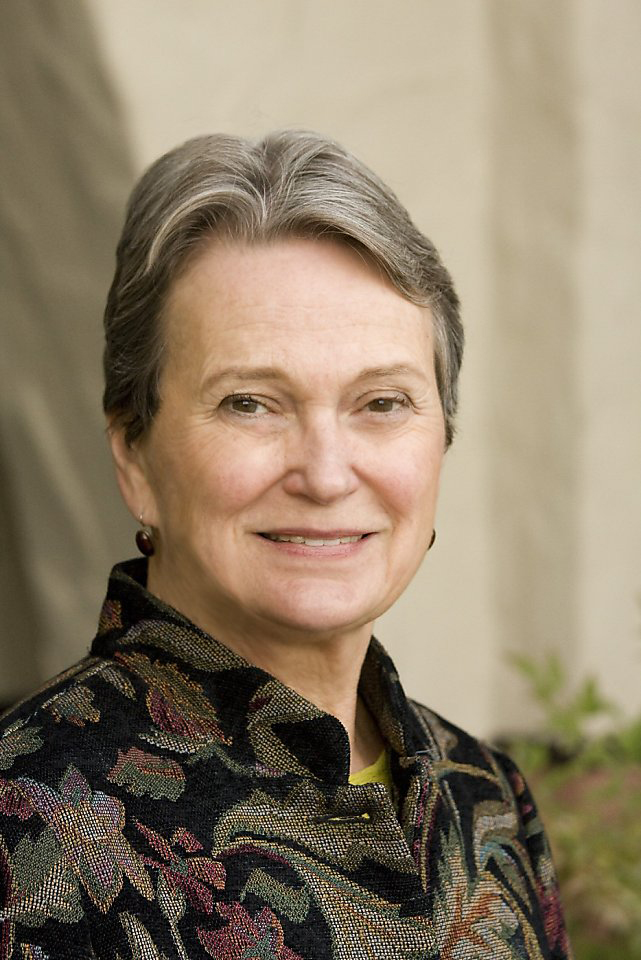
In spring 2021, I had the pleasure of interviewing the Hon. Loni Hancock for the California State Archives State Government Oral History Program. As an interviewer, one of my major areas of interest is the history of women’s political work, and Loni Hancock’s name appears over and over in the course of this study. Indeed, her life and work are integral to understanding California’s recent political history and the greater inclusion of women in elected office.
Loni Hancock is a former California State Senator (2008-2016), California State Assemblymember (2002-2008), Mayor of Berkeley (1986-1994), and Berkeley City Councilmember (1971-1979). Hancock was born in 1940 in Chicago, Illinois, and grew up in New York City. She attended Antioch College, Cornell College, and graduated with a BA from Ithaca College in 1963. Hancock later earned a MA from the Wright Institute in 1978. In addition to serving in elected office as a Democrat, Hancock also previously worked as the regional director for ACTION in the Carter administration, the director of the Shalan Foundation, and headed the Western Regional Office of the Department of Education in the Clinton administration. She currently partners with East Bay Supportive Housing Collaborative to advocate for supportive housing for people with serious mental illnesses, and is working to preserve Berkeley’s architectural heritage.
Hancock moved to Berkeley, California, in 1964 amidst the community’s reckoning with school desegregation and the Free Speech Movement. This zeitgeist in 1960s Berkeley inspired Hancock to follow her own interests in political activism. Indeed, it was her involvement in the local peace movement that propelled her into electoral politics. In her interview, Hancock explained, “Berkeley is a place where things begin. And whatever is in the air here has, I think, encouraged us to be standing up for what we believe is right, and arguing it out among ourselves.”
After an unsuccessful first campaign in 1969, Hancock won election to Berkeley City Council in 1971. For a time, she was the only woman on this governing body. Hear Hancock reflect on gendered expectations for Berkeley City Councilmembers in the 1970s:
After her time as Mayor of Berkeley, as well as work in several Democratic administrations and nonprofits, Hancock felt she could continue to contribute to her community by running for legislative office—first as a California State Assemblymember and then as a California State Senator. During her time in the California Legislature (2002-2008, 2008-2016), Hancock worked on many important issues. Notably, she was a major proponent of environmental legislation. Hancock introduced SCA-5 (later approved by voters as Proposition 25), which proposed passage of state budgets with a simple majority vote rule. She also advocated for criminal justice reform, including funding for prison education programs. Of this work, Hancock explained,
“One of the things we did was get a lot of prison education funded and implemented and get more money for rehabilitation programs. And actually, one of my best bills that was a my-idea bill was we gave full reimbursement for community colleges in California to run transfer-level courses in our state prisons. The idea being that you would get your basic first two years of college done, and then you could transfer to a UC or CSU on release…The recidivism rate goes down to virtually zero when that happens, so anyway, it makes safer communities, is what it does.”
Hancock’s legislative contributions have certainly helped shape recent California politics. But as the California State Legislature still struggles with gender parity of elected officials, her presence and perspectives as a woman in both bodies have also been key. In thinking about the strides toward greater representation of women in California politics, Hancock reflected,
“Well, we had our first woman speaker [in the Assembly], Karen Bass. We had our second woman speaker, Toni Atkins, who’s now the [Senate] pro tem. Those were milestones, really important milestones. You know, also, Karen was the first woman of color, and I’m guessing that Toni might be the first LGBTQ woman as a head [in California State government]…so you have women in leadership, which I think makes an interesting difference, and more women…So you know, there’s definitely progress, definitely.”
And Hancock’s tenure in California politics has certainly been a part of this progress. Read Loni Hancock’s oral history interview to learn more about her life and work in California politics!
Find this interview and all our oral histories from the search feature on our home page. You can search by name, keyword, and several other criteria.
About the Oral History Center
The Oral History Center of The Bancroft Library has interviews on just about every topic imaginable. You can find the interviews mentioned here and all our oral histories from the search feature on our home page. Search by name, keyword, and several other criteria. We preserve voices of people from all walks of life, with varying political perspectives, national origins, and ethnic backgrounds. We are committed to open access and our oral histories and interpretive materials are available online at no cost to scholars and the public.
Sign up for our monthly newsletter featuring think pieces, new releases, podcasts, Q&As, and everything oral history. Access the most recent articles from our home page or go straight to our blog home.
Panel with Bay Area Women Political Leaders on Zoom July 29
Come celebrate the launch of the Bay Area Women in Politics Oral History Project by joining us for a conversation about the history and future of Bay Area women in politics with former San Francisco Supervisor Louise Renne, Pittsburg Councilmember Shanelle Scales-Preston, and Oakland Mayor Libby Schaaf!
The panel discussion will take place over Zoom on Wednesday, July 29, from Noon—1 p.m. Pacific Time. Click here to RSVP. We will be moderating Q&A. If you would like to submit a question to the panelists, please email it beforehand to Amanda Tewes at atewes@berkeley.edu.
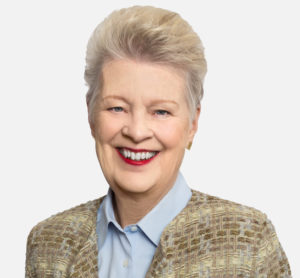
August 2020 marks the hundredth anniversary of women’s suffrage, and the anticipated nomination of a woman Democratic vice presidential candidate — both milestones of the national political roles for women. Here in the Bay Area, women have been driving political campaigns and activism for generations. Through first-person oral history interviews, the Bay Area Women in Politics Oral History Project from UC Berkeley’s Oral History Center will document and celebrate the lives and work of these political women, some of whom have been unsung.
To kick off this oral history project and to celebrate these milestones, join us for a panel conversation with three talented Bay Area women public officials: Louise Renne, Shanelle Scales-Preston, and Libby Schaaf! This panel will include discussion about the historical and current roles of Bay Area political women, lessons from across generations, as well as the challenges and opportunities facing women in politics.
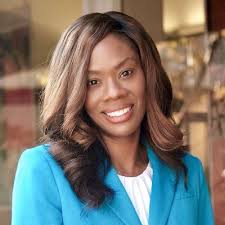
Louise Renne is a lawyer with the Renne Public Law Group, former San Francisco Supervisor (1978–1986), and former City Attorney for the City and County of San Francisco (1986–2001). She previously served as the General Counsel for the San Francisco Unified School District and as the City Attorney for the City of Richmond.
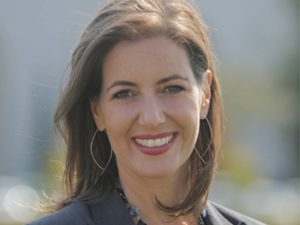
Shanelle Scales-Preston is a first-term member of the Pittsburg City Council, and District Director for Congressman Mark DeSaulnier. She previously worked for Congressman George Miller, and has been working in public service for nearly twenty years.
Libby Schaaf has been the Mayor of Oakland since 2015, and served on the Oakland City Council from 2011–2015. She was previously the Public Affairs Director for the Port of Oakland, and has a background in law.
The UC Berkeley Oral History Center is committed to putting voices in the historical record that might otherwise be lost, and providing the oral histories to the public at no cost. We are currently raising funds and need your help to undertake the expansion of this ambitious oral history collection. You can support this project by giving to the Oral History Center. Please note under special instructions: “For the Bay Area Women in Politics Oral History Project.” To learn more about this project, please contact Amanda Tewes at atewes@berkeley.edu.
New Library Digital Collection: 1920s-1930s Leisure from the Julian P. Graham Collection of Photographic Negatives
The Bancroft Library has announced that “over 500 photographs from the Julian P. Graham collection are now available via the Library’s Digital Collections site.
“This Bancroft Library collection of film negatives from Monterey area photographer Julian Graham has been the subject of ongoing interest over the years. It documents early years of the Pebble Beach and Cypress Grove golf courses, and the recreational life of California’s “high society” of the 1920s and 1930s, chiefly around the famous Hotel del Monte. The negatives, unfortunately, are largely on hazardous nitrate-based film, so are not available for library users until digitized.”
Exhibit: Institute of Governmental Studies Centennial
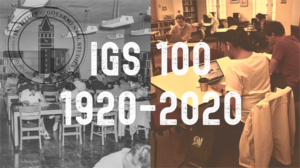 The Institute of Governmental Studies is celebrating its 100th anniversary this year! A hundred years ago, as efforts to reform government corruption were taking root across the country, IGS was founded by political scientists who saw an opportunity to build public administration into an academic discipline to educate new generations of civic leaders. The library has been the heart of IGS since its founding, and holds more than 400,000 items, many of them unique reports, pamphlets, bibliographies, and other ephemera.
The Institute of Governmental Studies is celebrating its 100th anniversary this year! A hundred years ago, as efforts to reform government corruption were taking root across the country, IGS was founded by political scientists who saw an opportunity to build public administration into an academic discipline to educate new generations of civic leaders. The library has been the heart of IGS since its founding, and holds more than 400,000 items, many of them unique reports, pamphlets, bibliographies, and other ephemera.
An exhibit now on display in the IGS Library highlights the people and projects that built IGS over the last century. The Institute will be celebrating its centennial with events and programs throughout the year, so please check igs.berkeley.edu for updates.
The IGS Library is open to the general public and the campus community from 10am-5pm, Monday through Friday. Email igsl@berkeley.edu or call us at 510-642-1472 with any questions.
Primary Sources: Diseños Collection at the California State Archives
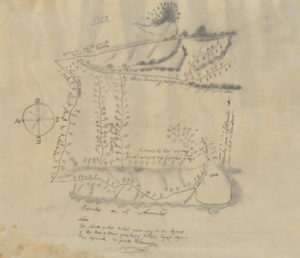
“Within the Diseños Collection there are 493 hand-drawn sketch maps, or diseños, that were created from approximately 1866-1871. These sketch maps were hand-copied from originals that were created from approximately 1827-1846. These are part of a larger collection that makes up the Spanish and Mexican Land Grant Records that also include expedientes, or written documents regarding the grant petition, and other related documents. Each diseño includes naturally occurring boundaries such as rivers, mountains, rock outcropping, and trees as markers. Many of the diseños have labeled neighboring properties and as part of the initial land grant process all boarders were agreed upon by surrounding landowners. The diseños also show existing travel routes, locations of houses and local place names.
“At the end of the Mexican-American War in 1848, California became a territory of the United States after Mexico and the United States signed the Treaty of Guadalupe Hidalgo. Among other things, the treaty directed the U.S. government to honor legitimate land claims of Mexican citizens in the territory. Following California’s statehood in 1850, Congress passed the Land Act of 1851 creating the Board of Land Commissioners. The Board used the diseños, expedientes, U.S. Surveyor General surveys, and other related title documents from landowners to verify individual land ownership and boundaries. Over a period of five years, the Board of Land Commissioners reviewed 813 grant claims, but only approved 553. The Mexican land grant process had a major influence on the development of California land by shaping settlement patterns and land ownership. As some of the earliest maps in California, diseños are essential to understanding the complex system of land ownership in the state today.”
California State Archives: https://www.sos.ca.gov/archives/collections/disenos-collection/
Primary Sources: National Farm Worker Ministry: Mobilizing Support for Migrant Workers, 1939-1985
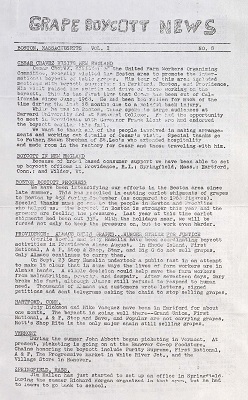 Another recent acquisition of the Library is the online archive National Farm Worker Ministry: Mobilizing Support for Migrant Workers, 1939-1985. These records of the California Migrant Ministry, which became the National Farm Worker Ministry, are part of the Archives of Labor and Urban Affairs housed at Wayne State University’s Walter P. Reuther Library.
Another recent acquisition of the Library is the online archive National Farm Worker Ministry: Mobilizing Support for Migrant Workers, 1939-1985. These records of the California Migrant Ministry, which became the National Farm Worker Ministry, are part of the Archives of Labor and Urban Affairs housed at Wayne State University’s Walter P. Reuther Library.
This collection reproduces correspondence, reports, speeches, minutes; included are materials relating to the farm workers, poverty programs, Public Law 78, Braceros, labor camps, the United Farm Workers Union and the Delano Grape Strike. The landing page for the online archive includes a descriptive list of contents.
Now Online: Images from Glass Negatives of the Panama-Pacific International Exposition
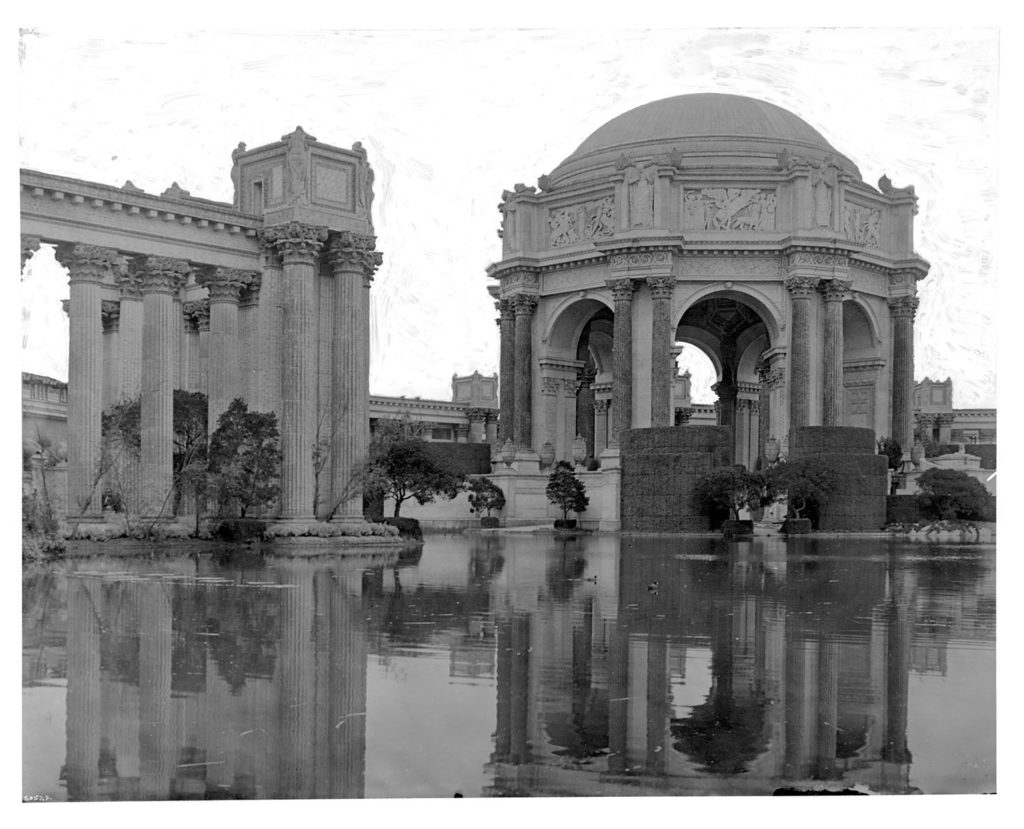
The Bancroft Pictorial Processing Unit is proud to announce that The Edward A. Rogers collection of Cardinell-Vincent Company and Panama-Pacific International Exposition Photographs has been organized, archivally housed, individually listed, and made (substantially) available online. This work was accomplished over two years, thanks to grant support from the National Endowment for the Humanities and, of course, careful hard work on the part of many library staff.
In this blog posting, Project Archivist Lori Hines describes some of the most challenging (and rewarding) work; preserving and providing access to fragile and often damaged glass negatives.
Handling Glass Plate Negatives: A Lesson in Mindfulness
The Rogers collection of Panama Pacific International Exposition photographs, received as a gift in 2014, includes over 2,000 glass negatives. These fragile items required special handling and archival containers with padding. Hardest to work with were approximately 150 oversize glass negatives ranging from 11 x 14 inches to 12 x 20 inches. Antique glass can become brittle and, of course, is heavy. From handling to wheeling the negatives back and forth to the conservation department and the digital lab, one had to be very conscious of every move and step taken.
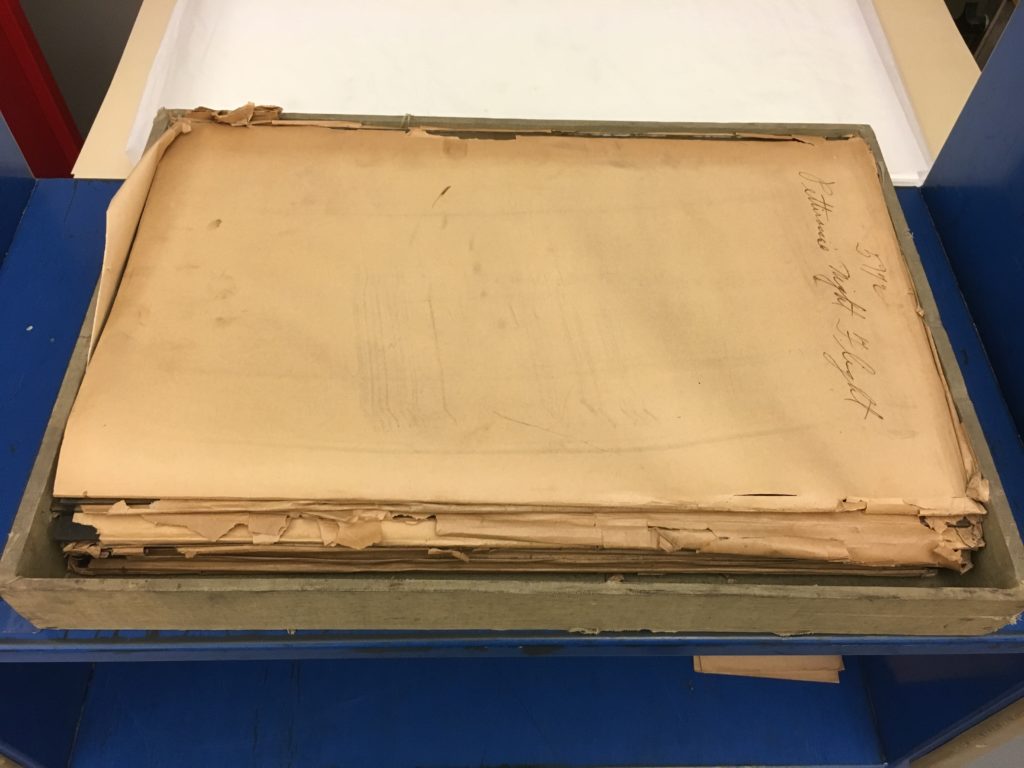
This first photo shows how the negatives were received in the library. Note they have no padding between the plates and there are only original, brittle sleeves to protect them. A stack of ten or fifteen is very heavy and getting your fingers under one, to lift it off the stack, is challenging. The weight of the negatives on top of each other is also a risk — the antique glass can easily crack under the weight.
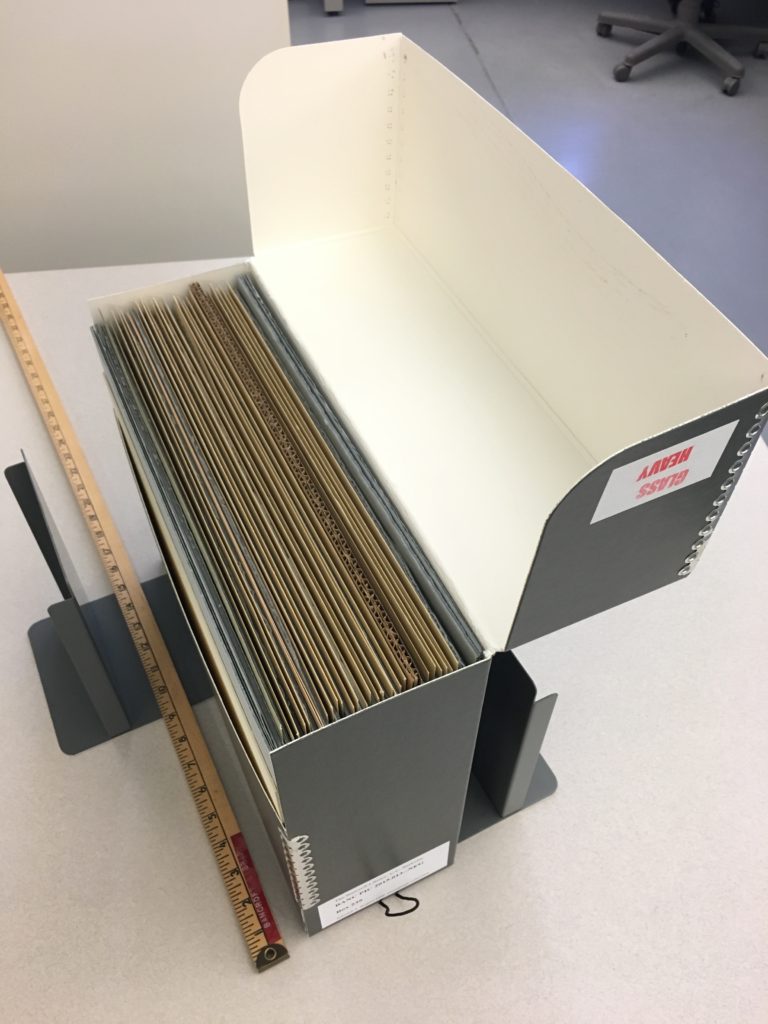
This photo shows how the negatives have been housed by library staff; vertically with corrugated archival cardboard around each. Our library conservators designed the housing to limit box weight, to provide protective padding, to protect the plates from abrasion as they’re removed, and to make handling safer.
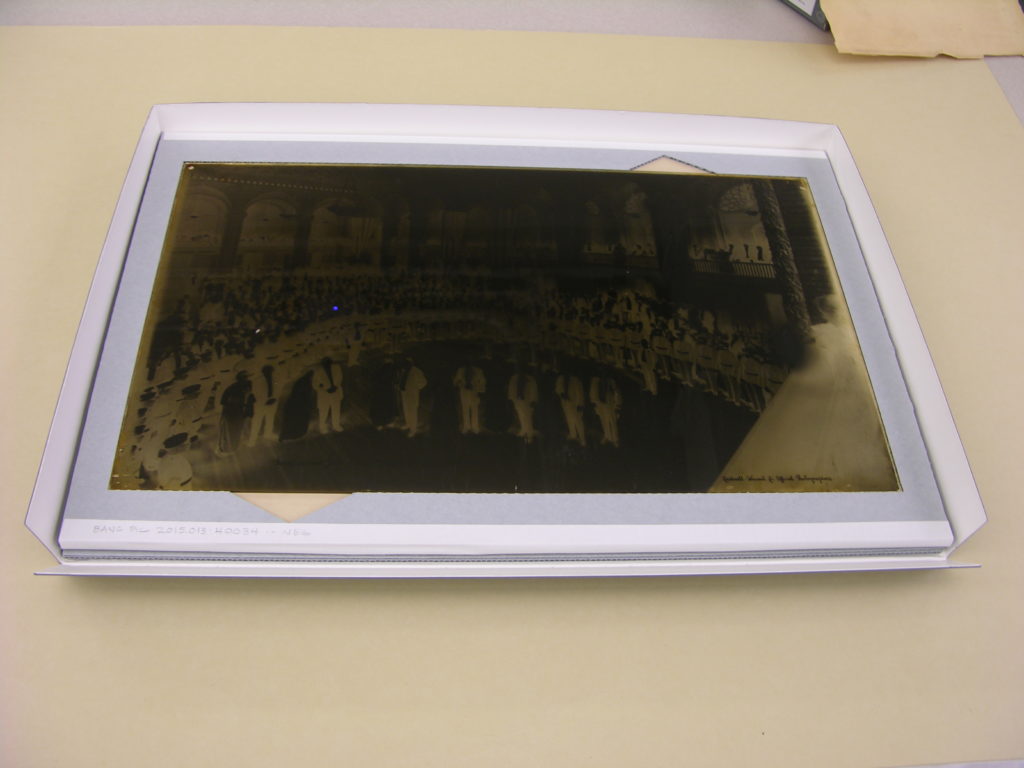
The largest plates, at 12 x 20 inches, needed another housing solution because it was impractical to store them upright, but the weight of one on another was a concern. The Library’s Conservation Department built custom trays to hold each 12 x 20 negative, with just three plates (and their trays) in an archival box that is stored flat on a cabinet shelf.
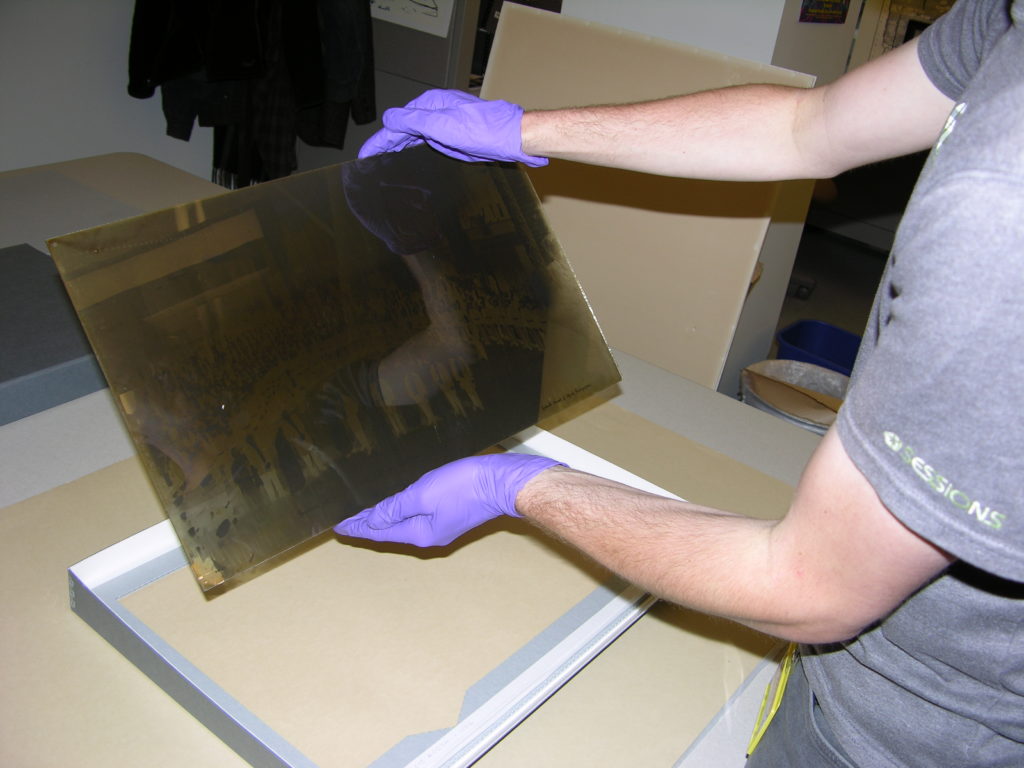
The negatives are handled on the long side of the glass to offer best support and, during the cleaning, housing, and inventory process, are rested on a piece of thin foam padding to buffer any impact with the work table.
About 10% of the negatives arrived broken. To be digitized, we had to re-piece the broken negatives together on a supporting sheet of glass, like a puzzle, then hand it off immediately to the photographer in the Library’s Digital Imaging Lab. The glass sheet with the broken negative on top was then placed on a light table, so it was lit from behind, to be captured by the digital camera. The light table and camera are visible in the background of this image.
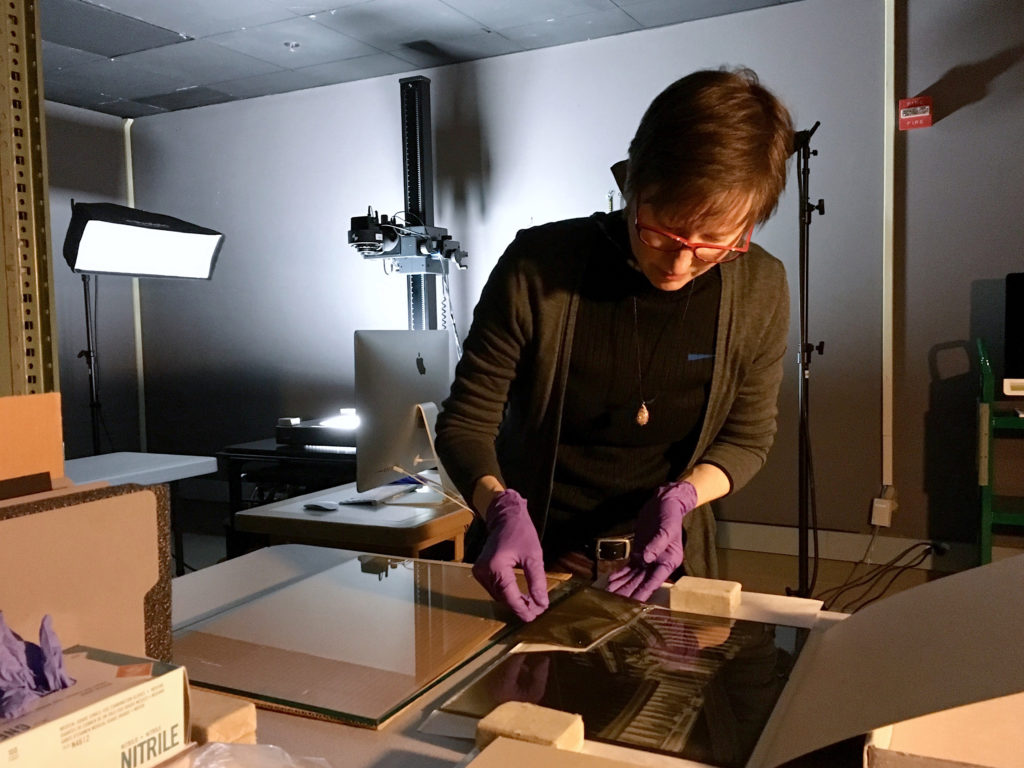
The results were often quite satisfying, as can be seen in this example of a badly broken glass negative that was pieced together.
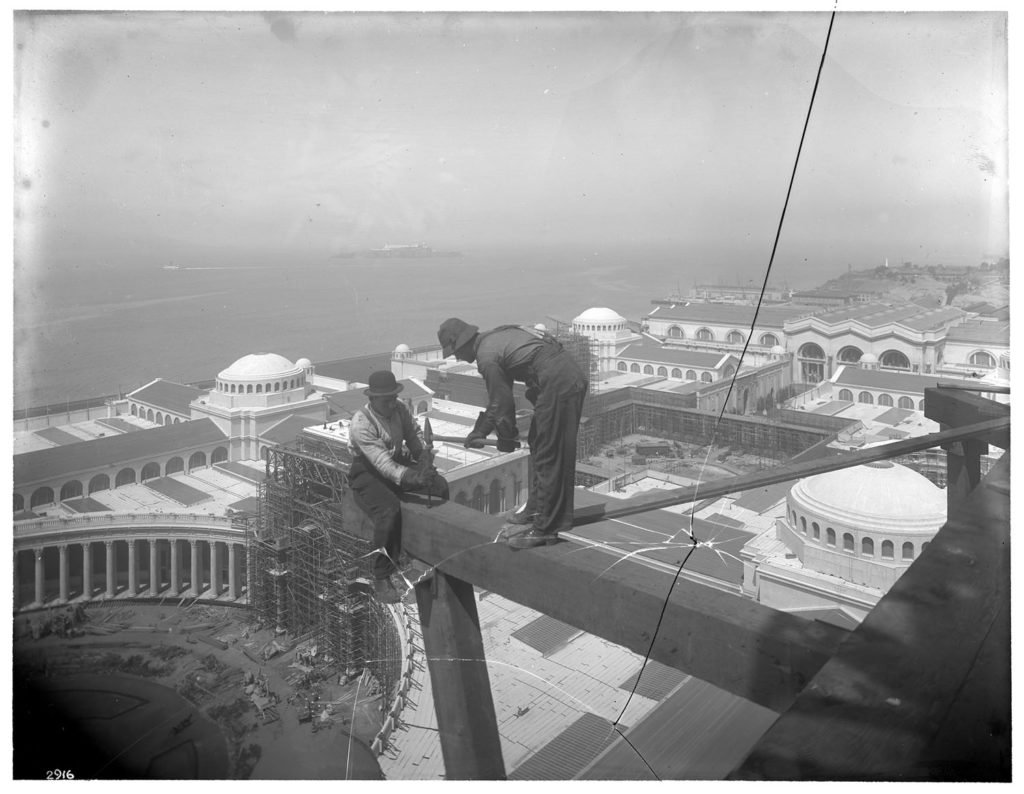
The finding aid describing and listing the entire Rogers collection, with more than 2,000 digital images, may be viewed at the Online Archive of California.
To browse examples of images scanned from broken plates, try searching the finding aid for “negative is broken”, and navigating through the results, or by browsing this Calisphere website search that retrieves just the broken-plate images.
Special thanks go to Christine Huhn and the staff of the Digital Imaging Lab; Hannah Tashjian, Erika Lindensmith, Martha Little, and Emily Ramos of the Conservation Department; staff of the Library Systems Office and the California Digital Library that worked with us to get the material online; to Gawain Weaver Art Conservation (contractors for preservation and scanning of panoramic film negatives), and to the Bancroft Pictorial Unit team that devoted much or their 2016-2018 work life to this effort: Lori Hines, Lu Ann Sleeper, and a crew of student staff.